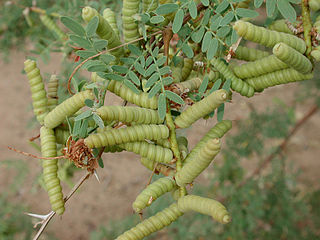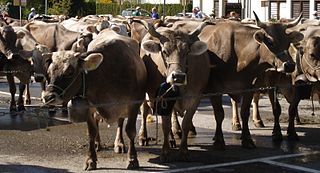
In ecology, a niche is the match of a species to a specific environmental condition. It describes how an organism or population responds to the distribution of resources and competitors and how it in turn alters those same factors. "The type and number of variables comprising the dimensions of an environmental niche vary from one species to another [and] the relative importance of particular environmental variables for a species may vary according to the geographic and biotic contexts".

An invasive species is an introduced organism that negatively alters its new environment. Although their spread can have beneficial aspects, invasive species adversely affect the invaded habitats and bioregions, causing ecological, environmental, and/or economic damage. Sometimes the term is used for native species that invade human habitats and become invasive pests. In the 21st century they have become a serious economic, social, and environmental threat.

The Himalayan tahr is a large even-toed ungulate native to the Himalayas in southern Tibet, northern India and Nepal. It is listed as Near Threatened on the IUCN Red List, as the population is declining due to hunting and habitat loss.

A keystone species is a species which has a disproportionately large effect on its natural environment relative to its abundance, a concept introduced in 1969 by the zoologist Robert T. Paine. Keystone species play a critical role in maintaining the structure of an ecological community, affecting many other organisms in an ecosystem and helping to determine the types and numbers of various other species in the community. Without keystone species, the ecosystem would be dramatically different or cease to exist altogether. Some keystone species, such as the wolf, are also apex predators.

Mesquite is a common name for several plants in the genus Prosopis, which contains over 40 species of small leguminous trees. They are native to the southwestern United States and Mexico. The mesquite originates in the Tamaulipan mezquital ecoregion, in the deserts and xeric shrublands biome, located in the southern United States and northeastern Mexico. It has extremely long roots to seek water from very far under ground. The region covers an area of 141,500 km2, encompassing a portion of the Gulf Coastal Plain in southern Texas, northern Tamaulipas, northeastern Coahuila, and part of Nuevo León. As a legume, mesquite is one of the few sources of fixed nitrogen in the desert habitat.

An introduced species, alien species, exotic species, adventive species, immigrant species, foreign species, non-indigenous species, or non-native species is a species living outside its native distributional range, but which has arrived there by human activity, directly or indirectly, and either deliberately or accidentally. Non-native species can have various effects on the local ecosystem. Introduced species that become established and spread beyond the place of introduction are considered "naturalized". The process of human-caused introduction is distinguished from biological colonization, in which species spread to new areas through "natural" (non-human) means such as storms and rafting.

Endemism is the state of a species being native to a single defined geographic location, such as an island, state, nation, country or other defined zone; organisms that are indigenous to a place are not endemic to it if they are also found elsewhere. For example, the Cape sugarbird is exclusively found in southwestern South Africa and is therefore said to be endemic to that particular part of the world. The extreme opposite of an endemic species is one with a cosmopolitan distribution, having a global or widespread range.

A landrace is a domesticated, locally adapted, traditional variety of a species of animal or plant that has developed over time, through adaptation to its natural and cultural environment of agriculture and pastoralism, and due to isolation from other populations of the species. Landraces are generally distinguished from cultivars, and from breeds in the standardized sense, although the term landrace breed is sometimes used as distinguished from the term standardized breed when referring to cattle.

A number of introduced species, some of which have become invasive species, have been added to New Zealand's native flora and fauna. Both deliberate and accidental introductions have been made from the time of the first human settlement, with several waves of Polynesian people at some time before the year 1300, followed by Europeans after 1769.
Charles Sutherland Elton was an English zoologist and animal ecologist. He is associated with the development of population and community ecology, including studies of invasive organisms.

In ecology, the term habitat summarises the array of resources, physical and biotic factors that are present in an area, such as to support the survival and reproduction of a particular species. A species habitat can be seen as the physical manifestation of its ecological niche. Thus, habitat is a species-specific term, fundamentally different from concepts such as environment or vegetation assemblages, for which the term habitat-type is more appropriate.

Native plants are plants indigenous to a given area in geologic time. This includes plants that have developed, occur naturally, or existed for many years in an area.
Autochthon, autochthons or autochthonous may refer to:
The need for a clearly defined and consistent invasion biology terminology has been acknowledged by many sources. Invasive species, or invasive exotics, is a nomenclature term and categorization phrase used for flora and fauna, and for specific restoration-preservation processes in native habitats. Invasion biology is the study of these organisms and the processes of species invasion.

Carpobrotus, commonly known as pigface, ice plant, sour fig, Hottentot fig, and clawberry is a genus of ground-creeping plants with succulent leaves and large daisy-like flowers. The name refers to the edible fruits. It comes from the Ancient Greek karpos "fruit" and brotos "edible".
Genetic pollution is a controversial term for uncontrolled gene flow into wild populations. It is defined as "the dispersal of contaminated altered genes from genetically engineered organisms to natural organisms, esp. by cross-pollination", but has come to be used in some broader ways. It is related to the population genetics concept of gene flow, and genetic rescue, which is genetic material intentionally introduced to increase the fitness of a population. It is called genetic pollution when it negatively impacts on the fitness of a population, such as through outbreeding depression and the introduction of unwanted phenotypes which can lead to extinction.

A pond is an area filled with water, either natural or artificial, that is smaller than a lake. Ponds may arise naturally in floodplains as part of a river system or can simply be an isolated depression that filled with runoff, groundwater, or precipitation. As such, ponds may be freshwater, saltwater, or brackish in nature.

The wildlife of Canada or biodiversity of Canada consist of over 80,000 classified species, with an equal number thought yet to be recognized. Known fauna and flora have been identified from five different kingdoms: protozoa ; chromist ; fungis ; plants ; and animals. Insects account for nearly 70 percent of recorded animal species in Canada.
Garden waste, or green waste dumping is the act of discarding or depositing garden waste somewhere it does not belong.
The Biodiversity of South Africa is the variety of living organisms within the boundaries of South Africa and its exclusive economic zone. South Africa is a region of high biodiversity in the terrestrial and marine realms. The country is ranked sixth out of the world's seventeen megadiverse countries, and is rated among the top 10 for plant species diversity and third for marine endemism.













